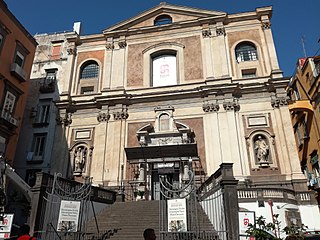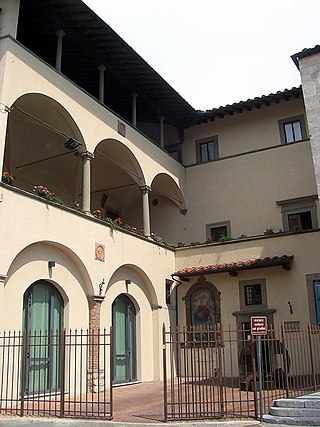 Museo diocesano di Sulmona | |
| Location | Sulmona |
|---|---|
| Type | Religious art |
Museo diocesano di Sulmona (Italian for Diocesan Museum of Sulmona) is a museum of religious art in Sulmona, Province of L'Aquila (Abruzzo). [1]
 Museo diocesano di Sulmona | |
| Location | Sulmona |
|---|---|
| Type | Religious art |
Museo diocesano di Sulmona (Italian for Diocesan Museum of Sulmona) is a museum of religious art in Sulmona, Province of L'Aquila (Abruzzo). [1]
The Diocesan Museum of Sulmona is housed in the three rooms of the Monastery of Santa Chiara. It represents a detached branch of the Civic Museum of Sulmona, as most of the works come from the churches of the Valle Peligna
The few but large rooms, which were once the residence of the Clares of the Monastery, house works from the late 13th century to the 18th century.
Noteworthy are many works by unknown artists, the Madonnas with Child from the 15th century, sacred vestments mostly from the 18th century, and goldsmithing from the 14th century and the late 17th century. There are few works originating from Sulmona; among these is the Saint James from the 16th century.
42°02′50″N13°55′34″E / 42.0471°N 13.9262°E

Santa Maria Donnregina Nuova is a church in central Naples, Italy. It is called Nuova ("new") to distinguish it from the older Angevin church of Santa Maria Donna Regina Vecchia.

The Diocesan Museum of Milan is an art museum in Milan housing a permanent collection of sacred artworks, especially from Milan and Lombardy. Originally conceived by Ildefonso Schuster in 1931 as a vehicle to protect and promote the art collection of the Archdiocese of Milan, the museum was eventually established in the former headquarters of the Dominican Order in the back of the Basilica of Sant'Eustorgio with the support of Pope Paul VI. In 2001 Carlo Maria Martini inaugurated the current venue located in Porta Ticinese.
The Diocesan Museum of Amalfi is an art museum housed in the 9th century Basilica del Crocifisso di Amalfi in Amalfi. It displays many of the treasures of the Roman Catholic Archdiocese of Amalfi-Cava de' Tirreni and is centrally located close to Amalfi Cathedral in Via Salita Episcopio.

The Abbey of the Holy Spirit at Morrone, known by various titles, is a former monastery some five kilometers outside of the town of Sulmona, at the base of Monte Morrone, in the Province of L'Aquila, region of Abruzzo, Italy.

Museo d'Arte Sacra della Marsica is a museum of religious art in Celano, Province of L'Aquila (Abruzzo).

Museo civico di Cerchio is a museum of religious art in Cerchio, Province of L'Aquila (Abruzzo).

Museo diocesano di Lanciano is a museum of religious art in Lanciano, Province of Chieti (Abruzzo).

Museo del duomo di Guardiagrele is a museum of religious art in Guardiagrele, Province of Chieti (Abruzzo).

Museo capitolare di Atri is a museum of religious art in Atri, Province of Teramo (Abruzzo).

The Diocesan museum of Brescia is a museum in Italy dedicated to the artistic patrimony of the Diocese of Brescia, and is located in the greater cloister of the Monastery of Saint Joseph in via Gasparo Salò, a short distance from the Piazza della Loggia.

The Cathedral museum of Prato, Italy was founded in 1967 in a few rooms of the Bishop's residence and in 1976 grew to include items from both the Cathedral of Saint Stephen and the diocesan territory.
The Diocesan Museum of Sacred Art (MuDAS) in Arezzo was founded in 1963 but opened regularly to the public only in 1985, and was housed in several rooms above the sacristy of the Cathedral of San Donato. In 2011 it was relocated to the first floor of the bishop's residence. The museum exhibits works of art and liturgical items, from the 12th to the 19th centuries, that come from the cathedral and other churches in the diocesan territory, significant for their religious and cultural significance to Arezzo and the surrounding area. Highlights of the museum include several works of Giorgio Vasari and the Pace di Siena.

The Assisi Diocesan Museum, in the city of Assisi, Italy, was founded in 1941 by bishop Giuseppe Placido Niccolini to preserve the most important works of art of the Assisi Cathedral and of several oratories of Assisi's confraternities. The museum is located underneath the piazza of the cathedral and has a collection consisting of about 300 works of which 100 are on display, exhibited in the museum's nine sections.

The Diocesan Museum is the museum of the Roman Catholic Diocese of Naples, displaying paintings, reliquaries and bronzes previously housed in the Archepiscopal Palace, closed and suppressed churches in the Diocese or churches where it is too risky to display artworks. The paintings are mainly from the Neapolitan School, including works by Luca Giordano, Francesco Solimena, Massimo Stanzione, Aniello Falcone and Andrea Vaccaro.

Santa Chiara is a baroque-style, Roman Catholic church located between corso Roma and Via Savelli, in the town of Antrodoco, province of Rieti, region of Lazio, central Italy. The church was once part of a Clarissan cloistered monastery, which included a hospital.
The Diocesan Museum of Palermo is a museum of religious art in Palermo on Sicily, housed in a number of rooms in the Palazzo Arcivescovile opposite Palermo Cathedral.

The Diocesan Museum of Pavia was founded in 2023 on the initiative of the Diocese of Pavia with the aim of protecting, enhancing and making known the artistic treasures of the diocese within the spiritual context that inspired them.

Priscus of Nocera was the first bishop of Nocera, patron saint of the city of Nocera Inferiore and of the diocese of Nocera Inferiore-Sarno.

Sant'Agostino is a 13th-century, Roman Catholic church and former monastery located on Piazza XX di Settembre, in the historic center of Volterra, Italy. The church facade is just northwest of the Biblioteca Guarnacci and Museo Etrusco Guarnacci. The church since 2017 was restructured to house the Museo Diocesano di Arte Sacra for the town of Volterra.